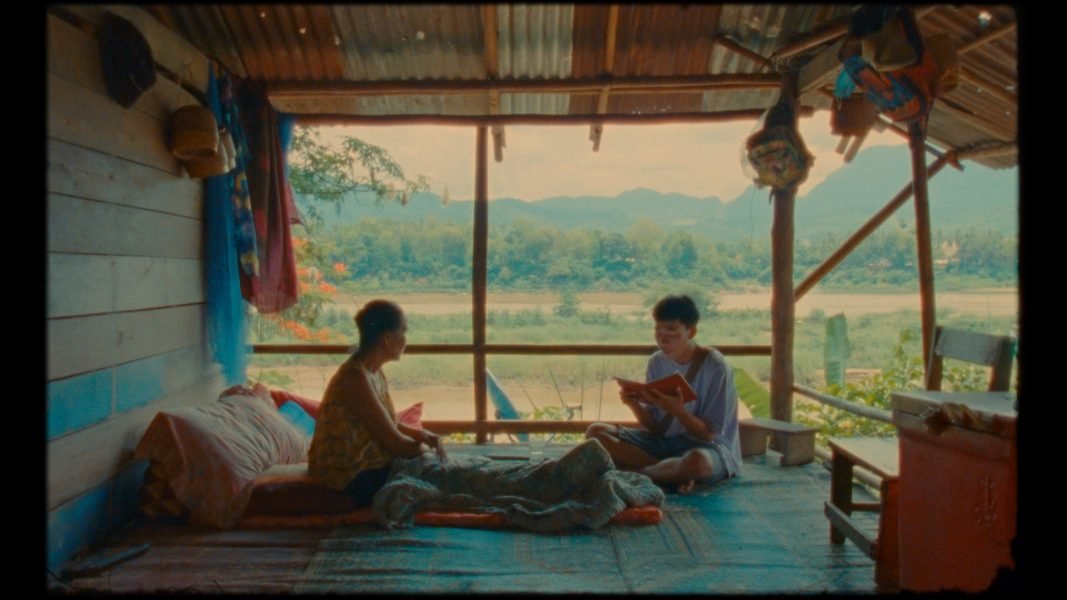Filmmaker Lois Patiño discusses the influence of James Turrell’s art, working with sound designer Xabier Erkizia and casting a baby goat in his astonishing new film, Samsara.
Samsara (Lois Patiño, 2023)
The cinema of Galician director Lois Patiño is characterised by a desire to elicit a transformative response from his audience. From his experimental documentary Coast of Death (2013) and its follow-up Red Moon Tide (2020) to his short films like The Sower of Stars (2022), Patiño manipulates cinematic language by using techniques like distancing and deceleration to reframe the landscape as a sublime force. His latest work Samsara - its title a reference to the Buddhist cycle of death and reincarnation - takes this approach to new, uncharted territories. The film opens in the temples of Luang Prabang in Laos, where a young man reads the Bardo Thodol (also known as The Tibetan Book of the Dead) to an elderly woman. Patiño then dramatises the transmigration of her soul from Laos, into the body of a newborn goat in Tanzania with a daring 15-minute interlude, in which he invites the viewer to join him on a voyage through the afterlife.
On behalf of ALT/KINO, Patrick Gamble spoke to Patiño about Samsara, his fascination with the afterlife, and his search for new, sensorial experiences.
Patrick Gamble: There’s a moment in the middle of Samsara where you ask the audience to close their eyes and submit to a succession of pulsating lights and disorientating sounds. Where did the idea for this sequence come from?
Lois Patiño: I’m always looking for different ways to reflect the invisible in cinema. I come from a contemporary art background and both my parents are painters, so I’ve always approached cinema as an art form where you can be innovative. When I make films the first thing I do is decide what element of cinematic language I can use to help me bring a different experience to the viewer, then one day I had this idea about making a film you could watch with your eyes closed. I knew I didn't want to make an experimental film, I thought the strength of this idea would be to situate it within a narrative, but I wasn’t sure how. Then I discovered the Bardo Thodol and realised I could use this idea to depict the Buddhist concept of reincarnation. I've always been interested in how different cultures view the afterlife, so it felt like the perfect fit.
PG: Was there anything in particular that inspired you when constructing this sequence?
LP: There’s this American artist called James Turrell whose work I admire. He makes these immersive environments using light and space. There’s this one piece I saw of his called Breathing Light which I loved. When you watch it, it feels like the light is actually breathing. It would fade in and out, as if it was inhaling and exhaling. I was also influenced by a sound artist called Francisco López. He had a piece in Madrid, where he gave the audience a mask that forced them to focus on the sounds he had created. Then of course there’s Derek Jarman’s Blue, and Brion Gysin’s Dreamachine which was described as the first art object to be seen with the eyes closed. It was basically this lamp with holes in it that produced a flickering sensation. I wanted to create something that felt like a combination of these pieces. An immersive sound and light experience. Some people have said to me that they didn’t feel comfortable closing their eyes during this sequence, but I like this contradiction of having an introspective experience in a room full of strangers. It’s a kind of collective meditation, but in the cinema.
PG: I liked how your use of drones in the afterlife sequence evoke everything from religious ceremonies to the rushing of maternal blood in the womb. Could you tell us a little bit about how you approached the sound design for the film?
LP: For the Bardo sequence I asked my sound designer Xabier Erkizia - this amazing artist and sound theorist - to divide the experience into two parts. For the first, we more or less followed the sounds described in the Bardo Thodol; so, you hear storms, wind and thunder. I wanted to create a physical experience, and really liked the vibrations created by these repetitive sounds. Then for the second part I asked him to introduce sounds that evoke images from different parts of the world. If you listen closely, you can hear a conversation between a young Italian girl and her grandfather, and a woman cooking in Timor, speaking in a lost language. Basically, Xabier hid all these sounds he’d collected throughout his career into the mix, then we used 5.1 surround sound, to make them emerge from different corners of the theatre. I wanted it to sound as if all these places were trying to tempt the soul to come and reincarnate there.
Samsara (Lois Patiño, 2023)
PG: Your two previous feature films, Coast of Death and Red Moon Tide both focused on the coastal landscape of Galicia, where you’re from, but with Samara you shot in the temples of Luang Prabang in Laos and Zanzibar in Tanzania. Were you ever worried about misrepresenting these communities?
LP: Of course. As a white European man, it’s important that I try and understand these cultures as best as I can. So, we consulted with lots of different people and tried to keep the dialogue as natural as possible by allowing a lot of improvisation. However, I also think it’s important that our cinema screens aren’t monopolised by Western stories and that we try to preserve different ways of living throughout the world. With this film I wanted to celebrate the diversity of our world and allow the audience to experience it from different perspectives.
PG: Another interesting aspect of the film is that you used two different directors of photography to shoot the sections in Laos and Tanzania. Mauro Herce and filmmaker Jessica Sarah Rinland. Could you tell us a little bit more about that decision?
LP: Well, since the film speaks about reincarnation, I knew that the perspective needed to change. I’m friends with both Mauro and Jessica, and since women aren’t allowed in the temples in Laos, Mauro had to shoot the first section. However, I always wanted Jessica for the second half because we arrive in Zanzibar after this ethereal middle section, and I wanted this part of the film to feel more tangible. This is the first film Jessica has shot for someone else, but if you’ve watched her films you’ll know that they’re very tactile. They often focus on hands and surfaces, plus she loves animals! So, she was perfect.
PG: Talking of animals, why did you choose a baby goat as the site for the soul to reincarnate?
LP: [Laughs] It was a decision I made very early on. I Knew I wanted to change the perspective radically from the first half, and that this point of view should be an innocent one. I chose a goat as I thought it reflected my distance from this community, but also because I wanted the audience to consider the way we treat animals, and to think about how animals experience the world around us. For me this is not a film about Laos, or Tanzania it’s about something else, something that sits between these two cultures.
Samsara is now in UK cinemas courtesy of Curzon and available via Curzon Home Cinema.
Patrick Gamble is a writer on film and culture, whose work has featured on Hyperallergic, BFI, Calvert Journal and Kinoscope. Further links to his writing can be found at patrickgamble.contently.com.


